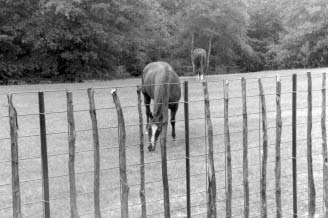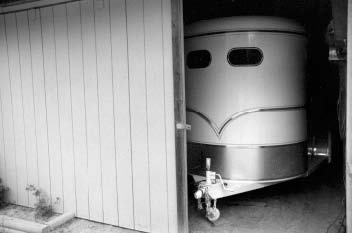Almost any victim of horse theft can attest to the emotional and economic effect of such a crime. Over the past several years, both large- and small-scale owners have suffered thefts of horses, trucks, trailers, saddles and other tack.
Horses and equipment are stolen from:
- Barns
- Farms
- Pastures
- Boarding and training facilities
- Competitive events
- Even from backyards
Tracking stolen horses can be difficult because theft reports are often delayed and stolen horses can change hands frequently and at remote locations.
Individual horse owners can take steps in the management and care of horses, facilities and equipment to minimize the risk of theft. Here are 15 steps to curbing horse theft. At least some of them should be applicable for every horse owner.
1. Permanently mark horses using one or more methods. Thieves are less likely to steal horses that are permanently marked, and those that are stolen are easier to track and recover. Horses can be marked permanently by:
- Freeze brand — using customized, number or letter iron and by alpha angle code methods;
- Hot iron brand
- Microchip, an implant; and/or
- Lip tattoo
- There are several different methods of permanent marking or identification available to horse owners.
2. Photograph horses and keep photos current.
- Photograph both sides of the horse as close as possible, being sure to get the entire horse in the frame. Although saddles, blankets, leg wraps and people may look good in a photo, they often impair the photo’s usefulness for identification.
Photograph the front of the horse, being sure to get a clear picture of the head. If possible, also take a rear view.
Take close-up pictures of any unique, identifying characteristics, such as a brand, permanent scar or white markings.
3. Establish an organized, easy to find, proof of ownership file. To save valuable time and frustration in proving ownership should a theft occur, keep on file:
- Registration papers, if the horse is registered with a breed association;
Dated bill of sale, and/or breed association transfer of ownership paperwork;
Photographs; and
Description of mark or brand and written description of all unique characteristics.
4. Record the permanent brand or mark with the county clerk’s office in the county where the horse lives.
- Registration helps law enforcement officers and brand inspectors communicate and determine ownership and can speed the process of filing theft reports.
5. Secure barns, corrals or pens from the road with a good perimeter fence and well-built gates that can be locked.
- Slowing a potential horse thief and/or making access to horses more difficult can deter theft significantly.
- Well-built perimeter fences help secure horses and deter theft.
6. If you plan to build a barn or corral, locate it away from the road.
- Place facilities beyond your house if at all possible. They are less likely targets if more difficult to access and require thieves to pass by a house.
7. Manage pastured horses to make theft more difficult.
- For safety as well as theft deterrence, never leave halters on pasture horses.
- Do not feed horses close to the pasture gate or near the road. Although convenient for owners, this practice actually helps potential thieves. Hungry horses will congregate around the usual feeding area making them easy to catch.
- Keep pasture gates locked.
- Check on pasture horses regularly and vary the time of your trips to the pasture.
- Absentee owners sometimes don’t realize for several days that their horses have been stolen from pastures.
8. Do not hang halters and lead ropes on stall fronts, corral gate posts or anywhere in the open.
- Secure halters in a locked tack room or feed room.
9. Permanently identify and lock up expensive tack.
- Consider having your driver’s license number engraved on the underside of saddles, expensive headstalls and other valuable items. While it will not prevent theft, locking the tack room does deter it by increasing the time a thief must be on your property.
- Deter theft by locking up halters and lead ropes.
10. Make horse and livestock trailers inaccessible, hide them from view and be able to prove ownership.
-
- Use commercially available locks to secure the hitch on a bumper-pull trailer. Many gooseneck trailers can be padlocked.
- Park trailers in a barn or somewhere hidden from traffic to make it harder for thieves to determine what is available and when or if horse owners are home.
- On commercially manufactured trailers, know where the VIN or serial number is located — often on the frame or tongue — and have the number on file.
- Know and record your trailer’s license plate number.
- Take and file photographs of your trailer.
11. Use signs and warning posters where appropriate.
- To signal to potential thieves that the owner is informed, active and aware, post such notices as:
- No trespassing signs
- Security system signs and
- Farm or livestock association membership signs.
12. Install motion-sensor lights.
- Motion-sensor lights turn on when they detect activity in strategic areas.
13. Talk to local law enforcement authorities about the value of dogs and other animals in deterring theft.
- Thieves dislike dealing with dogs. However, consider that dogs also require management.
14. Keep the activity level up around horses.
- Horses isolated from well-traveled areas and often left alone are easy targets. To deter theft:
- Vary your routine to make it difficult for potential thieves to know when you will be away.
- Avoid advertising when you are leaving town.
15. Establish a horse and facilities watch program with other horse owners in your area.
- Take turns checking on each other’s horses.
- Check on group members’ horses regularly when they are out of town.
Although horses and equipment will never be entirely safe from theft, many are stolen simply because it was made easy for thieves. Taking these steps to prevent theft will help you keep your horses and equipment safe.
For more information or more specific guidelines for individual situations, contact law enforcement authorities in your town, city or county. Many communities have crime prevention guidelines, suggestions or programs and sometimes even resource people who will speak to equine groups and associations.
Pete Gibbs and Leman H. Wall, Professor and Extension Horse Specialist, and Extension Assistant-Animal Science/4-H; The Texas A&M University System
References
Horse Theft Awareness and Prevention Fact Sheets from The Texas A&M University System, Pete Gibbs and The Equine Recovery Handbook.
Acknowledgements
Some of these suggestions or steps were originally published by Amelita F. Donald in The Equine Recovery Handbook. The author would like to acknowledge the assistance of Amelita F. Donald, member of Texas Cooperative Extension’s Horse Theft Awareness Advisory Committee, in the preparation of this manuscript. This publication was identified by Texas Cooperative Extension’s Horse Theft Awareness and Prevention Advisory Committee as a resource for direct support to horse owners.








